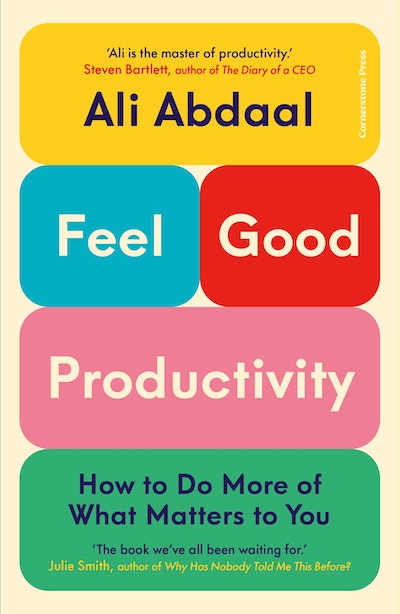- Published: 3 January 2024
- ISBN: 9781847943743
- Imprint: Cornerstone Press
- Format: Trade Paperback
- Pages: 304
- RRP: $40.00
Feel-Good Productivity
How to Do More of What Matters to You
Extract
‘Merry Christmas Ali. Try not to kill anyone.’
With these words, my consultant breezily hung up the phone, leaving me to handle an entire ward of patients alone. I was a newly qualified junior doctor, and three weeks previously I’d made a rookie error: forgetting to fill out a form to request the holidays off. Now, here I was managing a hospital ward, on my own, on Christmas Day.
Things had started badly and rapidly got worse. When I arrived at the hospital, I was met by an avalanche of patient histories, diagnostic reports and cryptic scan requests that would’ve made more sense to a seasoned archaeologist than our on-call radiologist. Within minutes, I was confronted by the day’s first emergency: a man in his fifties who had collapsed from a severe cardiac arrest. And then one of the nurses informed me that a patient urgently needed a manual evacuation (if you know, you know).
At 10:30am, I looked around the ward. Nurse Janice was sprinting up and down Corridor A in a panic, her arms overflowing with IV drips and medication charts. On Corridor B, a stubborn elderly patient was loudly demanding his misplaced dentures. Corridor C had been taken over by a drunken exile from the emergency department, wandering the corridor and shouting ‘Olive! Olive!’ (I never learned who Olive was.) And every minute, somebody was making a new demand: ‘Dr Ali, can you check on Mrs Johnson’s fever?’ ‘Dr Ali, can you help with Mr Singh’s elevated potassium?’
I soon found myself starting to panic. Medical school hadn’t prepared me for anything like this. I’d always been quite an effective student. Whenever the going got tough, my strategy was simple: work harder. It was a method that had got me into medical school seven years previously. It had allowed me to secure a handful of publications in academic journals. It had even allowed me to launch a business while I studied. Discipline was the only productivity system I knew. And it worked.
Except now, it wasn’t working. Since starting as a doctor a few months previously I’d felt like I was drowning. Even when I worked late into the night, I couldn’t see the number of patients or finish the paperwork that I needed to. My mood was suffering, too; I’d enjoyed my medical training to be a doctor, but I was finding the actual job utterly depressing, constantly worrying that I might make a mistake that would kill someone. I stopped sleeping, friendships faded, my family stopped hearing from me. And I just kept working harder.
And now this. Christmas Day, alone on a hospital ward, failing to get through my shift.
Everything came to a head when I dropped a tray of medical supplies, sending syringes flying across the linoleum floor. As I forlornly looked down at my damp scrubs, I realised I had to figure things out – or my dream of becoming a surgeon would slip through my fingers.
That night, I hung up my stethoscope and opened my laptop. I’d once been so productive, I thought. What had I forgotten? During my first year at medical school, Ihad become obsessed with the secrets of productivity. I had stayed up night after night making notes on hundreds of articles, blog posts and videos promising the key to optimal performance. All the gurus emphasised the importance of hard slog. A Muhammad Ali quote came up a lot: ‘I hated every minute of training, but I said, “Don’t quit. Suffer now and live the rest of your life as a champion.”’
As I went back over my old notes, I wondered whether that was where I was going wrong. Did I just need to regain my old work ethic? But when I returned to work the next day resolving to just do more, it made no difference. Even though I stayed on the ward until midnight – and even though I was reciting Muhammad Ali’s line to myself during my toilet breaks – I wasn’t getting through my paperwork any more quickly. My patients were still getting a tired, ineffective version of Ali. And my mood was still terrible.
At the end of my hardest day yet, I felt completely underwater. I found myself on the edge of giving up. And then from nowhere, I remembered some words of wisdom from my old tutor, Dr Barclay. ‘If the treatment isn’t working, question the diagnosis.’
Slowly, and then all at once, I started to doubt all the productivity advice I had absorbed. Did success really require suffering? What was ‘success’ anyway? Was suffering even sustainable? Did it make sense that feeling overwhelmed would be good for getting things done? Did I have to trade my health and happiness for, well, anything?
It would take me a few months. But I was stumbling my way to a revelation: that everything I’d been told about success was wrong. I couldn’t hustle my way to becoming a good doctor. Working harder wasn’t going to bring me happiness. And there was another path to fulfilment, one that wasn’t lined with constant anxiety, sleepless nights and a concerning dependence on caffeine.
I didn’t have all the answers, not by a long shot. But for the first time, I could make out the beginnings of an alternative approach. An approach that didn’t hinge on exhaustingly hard work, but on understanding what made hard work feel better. An approach that focused on my wellbeing first, and used that wellbeing to drive my focus and motivation second. A system I would come to refer to as Feel-Good Productivity.
The Surprising Secrets of Feel-Good Productivity
Back in medical school, my obsession with productivity had led me to tack on an extra year to earn a psychology degree. As I started putting together the pieces of feel-good productivity, I remembered a study I’d been tested on – one that involved a candle, a book of matches and a box of thumbtacks.
Picture yourself with these three objects before you. Your task is to stick the candle to the corkboard on the wall so that, when it’s lit, the candle wax won’t drip onto the table below. You find yourself puzzling over the items, turning them over in your hands. Can you think of the solution?
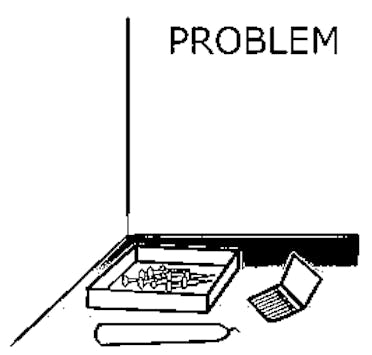
When presented with this problem, most people only consider the candle, the matches and the thumbtacks. But more innovative minds recognise the potential of the thumbtack box. The optimal solution to the puzzle involves viewing the thumbtack box not just as a container, but as a candle holder.
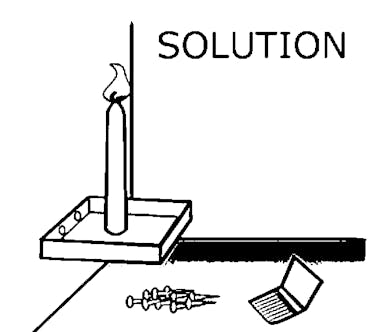
This is the ‘Candle Problem’, a classic test of creative thinking. First developed by Karl Duncker in 1945, it has since been used in countless studies testing everything from cognitive flexibility to the psychological fallout of stress. In the late 1970s, psychologist Alice Isen used it as the basis for an influential experiment to study how mood affects people’s creativity.
Isen began by dividing her volunteers into two groups. One group was given a small gift – a bag of candy – before facing the Candle Problem. The other group started the task with no such incentive. The theory went that those who were given the sweets would have a more positive mood when they tried to solve the puzzle. Isen found something interesting: those whose moods were subtly improved by the gift were significantly more successful in solving the Candle Problem.
When I first read about Isen’s experiment during my psychology degree, I found it interesting but not exactly transformative. Personally, I’d never felt the overwhelming urge to stick a candle to a wall. But coming back to it as a junior doctor, I realised that Isen’s insight was quite profound. It suggested that feelinggood doesn’t just end with feeling good. It actually changes the way we think and behave.
I now learned that the study had become the cornerstone of a wave of research exploring the way positive emotions affect many of our cognitive processes. It showed that when we’re in a positive mood, we tend to consider a broader range of actions, be more open to new experiences, and better integrate the information we receive. In other words, feeling good boosts our creativity – and our productivity.
One of the first people to explore how exactly this works was Barbara Fredrickson. A professor at the University of North Carolina, Fredrickson is one of the leading figures in positive psychology, a relatively new branch of psychology that focuses on understanding and promoting happiness. In the late 1990s, Fredrickson proposed what she called the Broaden-and-Build theory of positive emotions.
According to the Broaden-and-Build theory, positive emotions ‘broaden’ our awareness and ‘build’ our cognitive and social resources. The broadening aspect refers to the immediate effect of positive emotions: when we’re feeling good, our minds open up, we take in more information, and we see more possibilities around us. Consider the candle problem: in a positive mood, participants were able to see a broader range of potential solutions.
Build refers to the long-term effects of positive emotions. When we experience positive emotions, we build up a reservoir of mental and emotional resources that can help us in the future – resources like resilience, creativity, problem-solving skills, social connections and physical health. Over time, these two processes reinforce each other, creating an upward spiral of positivity, growth and success.
The theory suggests a whole new way of understanding the role of positive emotions in our lives. They’re not just fleeting feelings that come and go without consequence. They’re integral to our cognitive functioning, our social relationships and our overall wellbeing. Positive emotions are the fuel that drives the engine of human flourishing.
Why Feel-Good Productivity Works
When I first started learning about Broaden-and-Build, I caught a glimpse of a different way of thinking about my life. For years, I’d thought that by simply hustling harder I could achieve the things I wanted. If I wanted to be a good doctor, the life ahead of me would be defined by grinding, unrelenting work.
Now, I could see another way. Fredrickson’s theory suggests that positive emotions change the way our brains operate. Step one is feeling better. Step two is doing more of what matters to us.
But why, I wondered? The more I read, the more I realised that the explanations are varied – and in some cases remain unclear. But scientists have started to home in on a few answers.
First, feeling good boosts our energy. Most of us have felt an energy that’s not strictly physical or biological, one that doesn’t just come from sugar or carbohydrates, but from a mix of motivation, focus and inspiration. It’s the energy you feel when you’re working on a particularly engrossing task, or when you’re surrounded by inspiring people. This energy has many different names. It’s been labelled as ‘emotional,’ ‘spiritual,’ ‘mental,’ or ‘motivational’ energy by psychologists; ‘zest,’ ‘vitality,’ or ‘energetic arousal’ by neuroscientists. But if researchers can’t agree on what to name it, they’re agreed that it makes us focused, inspired and motivated to pursue our goals.
So what’s the source of this mysterious energy? The short answer: feeling good. Positive emotions are bound up with a set of four hormones – endorphins, serotonin, dopamine and oxytocin – which are often labelled as the ‘feel-good hormones’. All of them allow us to accomplish more. Endorphins are often released during physical activity, stress or pain and bring about feelings of happiness and diminished discomfort – and elevated levels usually correlate with increased energy and motivation. Serotonin is connected to mood regulation, sleep, appetite and overall feelings of wellbeing; it underpins our sense of contentment and gives us the energy to tackle tasks efficiently. Dopamine, or the ‘reward’ hormone, is linked with motivation and pleasure and its release provides a satisfaction that allows us to focus for longer. And oxycontin, known as the ‘love’ hormone, is associated with social bonding, trust and relationship-building, which enhances our capacity to connect with others, boosts our mood and, in turn, impacts our productivity.
All this means that these feel-good hormones are the starting point of a virtuous cycle. When we feel good, we generate energy, which boosts our productivity. And this productivity leads to feelings of achievement, which make us feel good all over again.
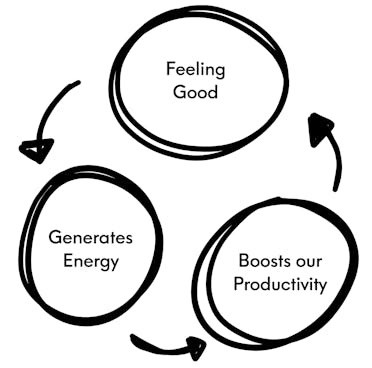
Second, feeling good reduces our stress. In addition to Broaden-and-Build theory, Barbara Fredrickson also developed what psychologists call the Undoing Hypothesis. Fredrickson and her colleagues were interested in decades of research showing that negative emotions cause the release of stress hormones like adrenaline and cortisol. This isn’t a problem in the short-term; it’s the mechanism that motivates us to run from danger. But if we experience these negative sensations too often, we become riddled with anxiety, and our physical health suffers. The continuous activation of these hormones can even increase the risk of developing heart disease and high blood pressure. Not ideal.
Fredrickson wondered about the flipside: if negative emotions have these harmful physiological effects, then perhaps positive emotions could reverse them. Might feeling good ‘reset’ the nervous system and put the body into a more relaxed state?
To test this out, Fredrickson came up with a rather mean study. Researchers told a group of people that they had one minute to prepare a public speech that would be filmed and judged by their peers. Knowing that the fear of public speaking is practically universal, Fredrickson hypothesised that this would elevate the subjects’ levels of anxiety and stress. And it did; people reported feeling more anxious, and experienced increases in heart rate and blood pressure. Next, the researchers randomly assigned participants to watch one of four films: two evoking mildly positive emotions, the third neutral ones, and the fourth sad ones. And they then measured how long it took the participants to ‘recover’ from the stress.
Their findings were intriguing. The participants who watched the positive-emotion films took significantly less time to return to their baseline state in terms of heart rate and blood pressure. And those who watched the sadness-evoking film took the longest time to return to baseline.
This is the Undoing Hypothesis: that positive emotions can ‘undo’ the effects of stress and other negative emotions. If stress is the problem, then feeling good might just be the solution.
But the final, and perhaps most transformative, implication of feel-good productivity goes well beyond any one task or project. Because third, feeling good enriches your life. In 2005, a team of psychologists read all the studies they could find on the complex relationship between happiness and success. They delved into 225 published papers which involved data from over 275,000 individuals. Their question: Does success, as we’re often told, make us happier – or could it be the other way round?
The study offered hard evidence that we tend to get happiness wrong. Individuals who frequently experience positive emotions aren’t just more sociable, optimistic and creative. They also accomplish more. These people bring an infectious energy to their environment, proving more likely to enjoy fulfilling relationships, get higher salaries and truly shine in their professional lives. Those who cultivate positive emotions at work morph into better problem-solvers, planners, creative thinkers and resilient go-getters. They’re less stressed, attract higher evaluations from their superiors and show a higher degree of loyalty to their organisations.
Put simply: success doesn’t lead to feeling good. Feeling good leads to success – in all areas of life.
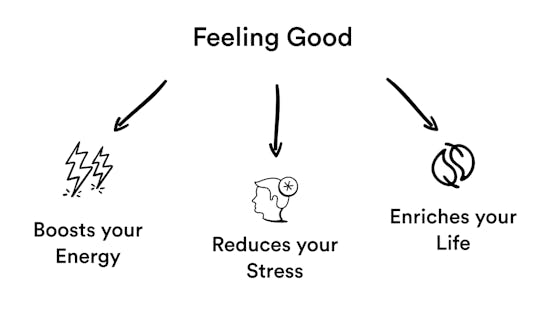
Feel-Good Productivity and How to Use It
Back in that first harrowing year as a doctor, most of these discoveries were still years ahead of me. I was working endless shifts and trying to shoehorn my productivity research into the fleeting breaks between visiting patients.
But even the basic insights I uncovered were enough to cause a dramatic change in my relationship with work. When I started to let go of my obsessions with discipline and focus instead on making work feel good, my horrific shifts started to get easier. Soon my mood started to improve too. I remember one appointment with an elderly patient a few months after I discovered feel-good productivity. ‘You know, doctor,’ she said. ‘You’re the first one in here who’s smiled all week.’
These new perspectives wouldn’t just alter my approach to being a doctor. They would alter the direction of my life altogether. For the first time in years, I began to see the opportunities beyond the confines of work: my friendships, my family and the other passions that I’d side-lined. And I soon found myself wanting to share my discovery. For a few years, I’d been running a YouTube channel on which I posted study tips and technology reviews. Now, I started sharing practical insights I’d learned from psychology and neuroscience, using myself as the guinea pig, experimenting with everything I learned and the strategies I thought might work.
As my radical notion that success doesn’t have to be tied to suffering started to gain traction, I started to get more and more emails from my viewers. High school students aced their exams, business owners doubled their income, parents managed to balance work and family life better, all by applying the strategies I was sharing. Even seasoned professionals, worn out from the grind of corporate life, were discovering fresh energy, motivation and new direction.
And so was I. The more I read, the more my philosophy developed. Eventually, by following the same principles and strategies I was learning about, I realised that I wanted to take a break from medicine to pursue something new.
That’s when I knew I had to write this book. What’s contained in these pages isn’t just another productivity system to help you get more done. It’s about doing more of what matters to you. It’ll help you learn more about yourself, what you love and what really motivates you.
My method has three parts, each of which tackles a different aspect of Feel-Good Productivity. Part 1 explains how to use the science of feel-good productivity to energise yourself. It introduces the three ‘energisers’ that underpin true productivity – play, power and people – and explains how to integrate them into your daily life.
Next, Part 2 examines how feel-good productivity can help us overcome procrastination. You’ll learn about the three ‘blockers’ that sap our energy – uncertainty, fear and inertia – and how to overcome them. When you remove these blockers, you won’t just overcome procrastination – you’ll feel better too.
Finally, in Part 3, we’ll explore how feel-good productivity can sustain us in the long term. We’ll delve into the three different types of burnout – overexertion burnout,depletion burnout and misalignment burnout. And we’ll explain how we can harness three simple ‘sustainers’ – conserve, recharge and align – to keep us going not just for days and weeks, but for months and years.
Every chapter contains its fair share of practical tips. But my goal in this book isn’t to offer you some sprawling to-do list. It’s to offer you a method: a new way of thinking about productivity that you can apply to your own life in your own way. My hope is that you leave this book an amateur ‘productivity scientist’: finding some methods that work, discarding others, and working savvily to see what helps you feel good and achieve more. That’s why every chapter contains not only three simple, science-backed ideas you can use to rethink productivity – but also six ‘experiments’ that you can implement in your own life. If an experiment works for you, great – if it doesn’t, then that too is a helpful ‘data point’. By the end of the book, though, you should have a toolkit for applying Feel-Good Productivity to your own work, relationships and life.
Because if there’s one thing I’ve learned by immersing myself in the science of Feel-Good Productivity, it’s that it applies in every sphere. It turns daunting tasks into engaging challenges. It leads to deeper connections with peers. It drives meaningful interactions in what you do, every day.
By understanding and applying what makes you feel good, you won’t just transform your work. You’ll transform your life.
Feel-Good Productivity is a simple method. But it changes everything. It shows that if you’ve ever felt underwater, you don’t have to settle for staying afloat. You can learn how to swim.
Let’s dive in.
Feel-Good Productivity Ali Abdaal
The world's most-followed productivity expert reveals how to achieve more by finding joy in everything you do.
Buy now